Last month, we asked whether NFTs could revitalize traditional print media just as men’s fashion magazine GQ announced its then-upcoming inaugural NFT drop. It seems an affirmative answer remains elusive, at least for now.
GQ‘s NFT, called “GQ3 Issue 001: Change Is Good,” went on sale on March 8 and has underperformed ever since. OpenSea data indicates that the average price of the collection dropped from 0.2017 ETH (about $360.90) on March 8 to just 0.0583 (about $104.30) ten days later. Additionally, Decrypt reported on March 10 that only 1,060 of the 1,661 pieces had been sold, a number that remained unchanged by March 18.
To reward buyers and potentially boost the collection’s relevance, GQ stated it would randomly drop half of the remaining NFTs to existing holders.
It’s too early to pinpoint why GQ‘s drop didn’t live up to the hype. After all, the publisher combined each NFT with tangible benefits like exclusive merchandise and magazine subscriptions. However, one possible reason is the NFTs’ lack of connection to GQ‘s core content. Browsing OpenSea reveals that the collection consists of modern art pieces from various artists.
While creative and impressive, they don’t demonstrate a connection to men’s fashion. Readers enthusiastic about GQ‘s regular coverage may be disappointed to find the style and themes of GQ‘s NFTs notably different from what they see in the magazine.

OpenSea data indicates flagging interest in GQ’s inaugural drop since its debut. Image: OpenSea
As with other NFT flops from renowned brands, GQ‘s subpar NFT performance suffers from a lack of clear focus. The collection, artistically rich as it may be, doesn’t seem to cater to GQ‘s audience. Instead, GQ likely succumbed to the Fear of Missing Out (FOMO) when it realized multiple other print media outlets, such as Rolling Stone and TIME, had issued their own NFTs.
Eager to showcase its ingenuity in the digital age and better connect with readers, GQ commissioned artists and released the NFTs. While there are many upsides for media to release NFTs, media platforms need to carefully determine what type of content can represent their legacies while generating the highest amount of interest from their readership before minting their NFTs.



